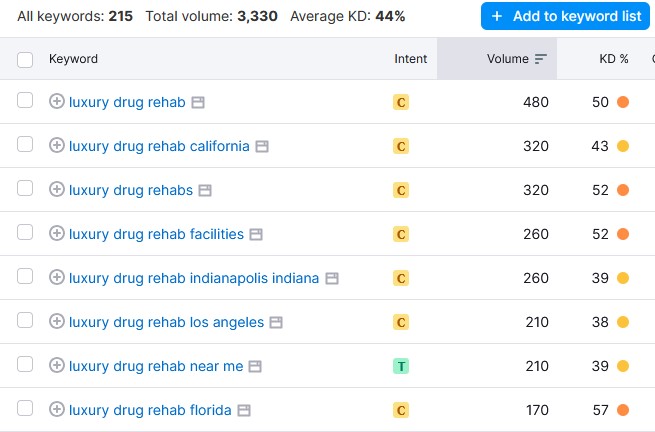When families are in crisis and looking to help a loved one battling addiction, they’ll start with a Google search like “drug rehabs near me” to find a local facility. However, for drug rehabs that haven’t optimized their online presence for local searches, their results probably won’t appear as frequently as other rehabs that invest in local SEO.
Drug rehabs should prioritize ranking on the first page of Google’s search engine results page (SERP) and increasing visibility through a well-optimized Google Business Profile. This dual approach maximizes your chances of being discovered by potential clients who are furthest down the conversion funnel and ready to make a call.
As you consider improvements for your organic search strategy, use our guide to master every facet of local SEO, from creating a balanced keyword mix to creating a trustworthy, high-value Google Business Profile.
Keyword Research

The foundation of any successful SEO strategy is keyword research, which identifies the words or phrases that potential clients and their families search. Integrating these keywords thoughtfully can improve your online visibility, resulting in more search traffic and, ultimately, higher conversion rates.
These keywords fall into two main categories: short-tail and long-tail.
Short-Tail Keywords
Short-tail keywords, or head terms, are very general. While they have a higher search volume, they’re also more competitive, attracting a broad audience with varying search intents.
A few rehab-related short-tail keywords include:
- drug rehab
- addiction treatment
- alcoholism rehab
- rehab center
Long-Tail Keywords
Long-tail keywords are more specific phrases — typically three or more words — with a qualifier, such as the location or industry-specific descriptor. They represent the long tail of the search demand curve, attracting lower search volume but higher conversion rates.
This occurs because keywords like “affordable drug rehab near Springlake” or “inpatient addiction treatment for teens” are more likely to be searched by people who are ready to take action.
Some long-tail keywords include:
- best addiction treatment programs near me
- alcohol rehab in [city]
- inpatient drug rehab facility near [city]
- [state] outpatient addiction treatment
Creating Your Keyword Mix
The most successful local search strategies use a mix of both types of keywords. This means the content is relevant to a broad audience but also caters to a more targeted audience with your specific services in mind.
Tools like Google Keyword Planner, Ahrefs, SEMrush, and Moz can provide databases of the terms most relevant to your services, including assessments of their search volume and ranking difficulty.
They can also pull in data about your competitors to uncover related terms you can create content around to close gaps in your existing local SEO strategy.
Optimizing Your Google Business Profile and Reviews

In 2014, Google launched the Google My Business feature to make search results more useful and valuable to users. Instead of having to click through to a website to find contact information, searchers could now see listings of businesses and organizations most relevant to their query. We now know it as a Google Business Profile, but it serves the same purpose and continues to be one of the most crucial local SEO ranking factors.
Local results appear before regular organic search results, creating a one-stop shop for basic details — name, location, phone number, and hours of operation — organized alongside customer reviews and Google Map directions.
The top-billed listings are highly competitive because Google doesn’t want to recommend untrustworthy or poorly reviewed businesses to its users. So, to increase your chances of securing one for your drug rehab facility, you should optimize your Google Business Profile according to algorithmic SEO ranking factors.
The first factor, relevance, measures how well your drug rehab meets the searcher’s needs.
Distance ranking prioritizes results closest to the user’s location-based query or GPS location data when no location is provided in the search.
Finally, prominence means that the more well-known, better-reviewed results are more likely to appear before lesser-known results with poor reputations. It also uses data like your website’s SERP ranking, inbound links, and references on other websites, making it the most complex and controllable factor.
How to Optimize Your Google Business Profile for Local Searches
A well-optimized Google Business Profile ensures that your rehab center appears prominently in local search results and Google Maps, increasing your visibility and attracting more inquiries. Make sure that your profile ticks all these boxes:
- Every section of your Google Business Profile is complete and accurate to eliminate discrepancies that can confuse search engines and potential clients.
- You’ve selected the appropriate categories to help Google understand what your business offers and match it to relevant searches.
- There are professional, high-quality photos of your facility to boost your profile’s appeal and give your future clients a sense of what to expect from your drug rehab services.
- You regularly encourage and respond to reviews, showing that you value feedback and are committed to improving your practices according to client needs.
- The profile regularly updates with posts about new services, upcoming events, or any other information related to addiction recovery, keeping your clients engaged and your services relevant to search engines.
Building and Managing Local Listings and Citations
Every time your business is mentioned online, whether on a platform you control or externally, it gains a citation. The more citations your drug rehab has on authoritative directories and websites, the more search engines and potential clients are inclined to trust that your facility is one of value, as it has earned recognition and recommendations from third parties.
However, if the information included in that citation isn’t accurate — specifically the name, address, and phone number (NAP) — it can hurt the trust you’re trying to build. Search engines can get confused about which NAP information to provide to searchers, and if they choose the wrong version, it can lead to frustrated people who get a disconnected line or visit your previous address.
You can prevent these situations by regularly monitoring your NAP citations services like Moz Local Citation Checker and Neunom’s Business Local Listing NAP Citation Scan Tool. They do the hard work of pulling every instance of your drug rehab’s NAP citations from Yelp, healthcare directories, local resource listings, social media, and the like so you have an easy-to-reference list of which entries need updating.
On-Page Optimizations for Local SEO

Have you ever heard the phrase “content is king?” It’s an oft-quoted piece of advice in the digital marketing community that reflects the value that well-written, high-quality, keyword-optimized content has on Google’s search results.
Remember that quip when integrating your search terms throughout your website and Google Business Profile. Taking “black hat” SEO shortcuts like keyword stuffing or throwing together blog articles with few meaningful insights won’t yield the ROI you’re hoping for. In fact, you’re more likely to lose any traction you’ve already gained due to the search engine’s penalty system.
Instead, you must be strategic, weaving them into key areas that Google depends on to determine the content’s value and relevance. Here’s where to start:
- Title tags and meta descriptions should include primary keywords to improve click-through rates.
- Cascading headers can contain the primary keyword and variations.
- In the body content, naturally, integrate primary and supporting keywords as needed so they read well and provide obvious value to your audiences. A good rule of thumb is 1% to 2% keyword density or 1 to 2 uses per 100 words.
- URL slugs with the target search phrase help search engines determine the page’s relevance.
- Image alt text or photo descriptions required for screen-reader accessibility help your site meet the ADA requirements and offer additional opportunities to increase the times your term naturally appears in the content.
Those are the basic requirements that every website should follow every time it gains a new page or blog post, but there are two additional measures you can take to give your drug rehab the edge in local SEO.
On-Page SEO Tip #1: Service Pages With Local Keywords
To further attract local SEO traffic, create dedicated pages for the specific services, then optimize them for local keywords. For example, you can build a page explaining your intensive outpatient program and specify that these services are available in Houston:
- Title tag/H1 header — “Effective Intensive Outpatient Program in Houston”
- Meta description — “Our intensive outpatient program in Houston is evidence-based and effective care for individuals overcoming drug addictions.”
- URL slug — /houston-intensive-outpatient-program
On-Page SEO Tip #2: Internal Linking
Finally, you can increase your value to users and your SEO rankings by building a web of internal links throughout your site that connect relevant pages. An example could be linking from a page about your residential treatment program to a blog post detailing the most effective forms of drug addiction therapy or a related page on outpatient treatment.
Users benefit because internal links help them fluidly navigate to other content that might interest them. This keeps them engaged with your site longer and demonstrates your authority on a broader range of topics related to addiction rehabilitative care.
Search engines also appreciate these efforts because they improve your site’s crawlability, making finding and indexing your pages more efficient. Internal links go even further by providing a better context for that index, helping crawlers define how relevant the topic and content on a particular page are for a specific keyword.
Technical SEO: Improving the User Experience of Your Rehab Facility’s Website
When determining who appears in local searches, Google’s goal isn’t just about relevance but also the experience users can expect when researching a recommendation.
Therefore, websites that consistently demonstrate high usability can edge out those that are slow or clunky, even if they are neck-and-neck for on-page and Google Business Profile ranking factors.
Prioritize the following for the biggest impact on your search rankings:
Website Architecture
While it’s true that search engines don’t “use” your site the same way that people do, Google still wants to see clear signals that the experience is a pleasant one for their searchers. You can achieve this feat by crafting an intuitive structure that encourages visitors to interact with your on-page elements, dig deeper into your content, and follow a clear navigation path through the user journey. And, just like with internal linking, excellent site architecture makes it much easier for Google to index all of your pages correctly by putting each one in the larger context of what your facility has to offer.
Mobile Optimization
In the last decade, smartphones’ share of search traffic has skyrocketed from 31.16% to 53.42%. With it now being the dominant search method, it’s unsurprising that Google’s mobile-first indexing prioritizes results that offer a seamless, responsive design that automatically adapts to different devices. Otherwise, users will quickly become frustrated by top-ranking results they can’t interact with due to poor mobile performance, regardless of how well the facility meets the needs of their query.
Speed and User-Friendliness
When visitors land on your site, you have 1 to 2 seconds to engage them before the bounce rate increases incrementally from 9% to 38% by the 5-second mark. While that’s certainly not a generous amount of time, it’s a superior experience compared to the average site load speed of 2.5 seconds. If you can get your site up to speed, your users will be more engaged, leading to higher conversion rates and increased admissions. It also signals to search engines that you’ve put the work into building an optimized, user-friendly experience.
Partner With Experts to Perfect Your Drug Rehab Local SEO Strategy
Running a treatment center is a full-time job, which makes it challenging to step away and invest time in local search optimization. That’s why Rehab Media has perfected the process over more than a decade.
Our full-stack SEO services for drug rehabs cover every step of the optimization process, from conducting competitive analyses to lead generation, all informed by our in-depth knowledge of healthcare marketing.
Reach out today to request a local SEO proposal tailored to the needs of your drug rehab facility.

Molli Kelly has been in digital marketing since 2015, first as a copywriting side gig while completing her Master’s in Education. After teaching middle school science and math for six years– while continuing to upskill and freelance- she transitioned into a full-time SEO strategist position in 2022. Since then, she’s worked with clients ranging from personal injury attorneys to Indigenous herbalists to ensure their content gets in front of the audiences who would most benefit from their expertise.

